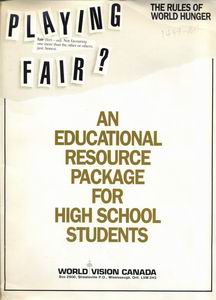

|
|

Playing Fair?
Publisher: World Vision CanadaYear Published: 1990 Resource Type: Pamphlet Cx Number: CX4113 An ingenious mix of entertainment and information, Playing Fair explains world hunger to high-school students with games and an attention-grabbing format and layout. The kit consists of five lessons, each accompanied by a board game. Abstract: An ingenious mix of entertainment and information, Playing Fair explains world hunger to high-school students with games and an attention-grabbing format and layout. The kit consists of five lessons, each accompanied by a board game. The introductory lesson emphasizes the simple but ignored truth that poverty (and not overpopulation, ignorance, natural disaster or laziness) is the real cause of hunger. Subsequent lessons target more specific topics, illustrating the relation between hunger and land use, the forests, international trade, and the international debt crisis. Outside of the games, information is packed into short, hard-hitting paragraphs: "We like to talk about the `population explosion' in the Two-Thirds World. But what about the consumption explosion in the West? The average North American kid consumes forty times more of the world's resources (not just food, but energy, water, and manufactured goods) than a kid in the developing world." The games that accompany the lessons get students actively involved in the issue. In each game, winning involves overcoming some manifestation of poverty and hunger. Depending on the lesson, players represent either a Latin American country trying to get out of debt, an African trade representative trying to obtain a basic supply of oil, farm machinery and processed food, or poor farmers struggling against an advancing desert, struggling to expand their land, or struggling to escape the hunger cycle. In each case, the games are very hard to win -- in fact, they're unfair -- which is, of course, the kit's most important lesson. Subject Headings |